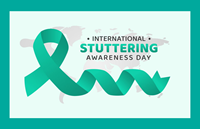

I entered the clinic room anxiously. A newly qualified speech and language therapist schooled, but not yet skilled, in the complex communication difference that is stammering. Following discussion with my senior colleagues and a deep dive into my clinic’s resources I was armed with therapy materials. A small felt snail, some laminated snail pictures (for home practice) and picture cards. My plan? I was going to teach this little boy to speak slowly, like a snail, to reduce his “bumpy words”.
You can imagine my alarm when, twenty minutes later, that same snail was sent hurtling through the air towards my head! Its four year old launcher stood triumphantly shouting “I hate snail talking, but I love my talking”. Luckily, I had the good sense to be humbled by this little sage. There was such wisdom in his words. He liked how he spoke, he didn’t need or want me to “fix it”
In my seventeen years of practice, as a speech and language therapist, since, I have tried to honour that lesson. The voice of the person who stammers is the only one that matters. Thankfully, most of today’s stammering interventions focus largely on the emotional and cognitive aspects of stammering. The goal of therapy is to help the child be a competent communicator, regardless of whether they stammer or not. It has been an additional joy to witness the stammering pride movement unfold and grow.
On this International Stammering Awareness Day my wish for all children who stammer is that they will shout loudly and proudly
“I love my talking”
Marie Nicholas
Senior Speech and Language Therapist,
CORU: SL018150